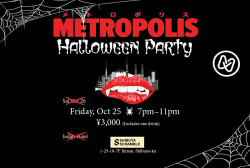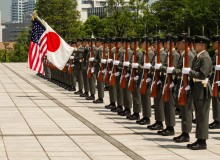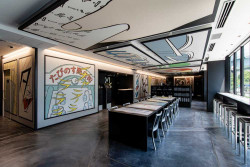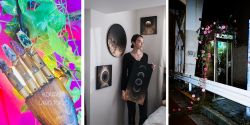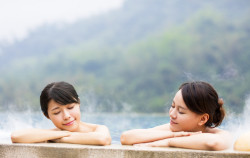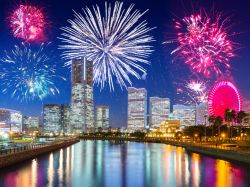
May 19, 2007
Companions of the Sea
Life in the Seto Inland Sea town of Tomo-no-Ura revolves around its fishing industry. Stephen Mansfield experiences the salty charm.
By Metropolis
Originally published on metropolis.co.jp on May 2007

Photos by Stephen Mansfield
Since the publication in English of Yukio Mishima’s 1954 “The Sound of Waves,” an uncharacteristically romantic novel of young love flowering on an islet in the Seto Inland Sea, there’s been a fondness for visualizing the sea as somehow Mediterranean in flavor, its water passages carrying the traveler on an Ionian journey. Donald Richie’s classic “The Inland Sea” also contains a little of this longing for an antique land, a place whereupon “somewhere near the sea…I will find them: the people the Japanese ought to be, the people they once were.”
The Inland Sea easily inspires moments of somber poetic meditation. In the tiny port of Tomo-no-Ura, at the very extremity of the Numakuma Peninsula, one may savor the smell of the sea, squawking gulls, the sight of kites wheeling over the temple roofs, and fleeting images of history. The warrior Masashige passed through here on his way to Kyushu; so, too, did the Empress Jingu en route to Korea, as well as straggling bands of the defeated Heike clan.
Life on the sea
Tomo-no-Ura has not entirely escaped Japan’s post-war “uglification” program as some of its cement installations testify. The town seems to have had its last flirt with concrete in the ’80s, and then mercifully left it at that. Whether it is the preservation ethic triumphing over modernity or just the economy, the village remains largely a creation in wood. Where there is concrete, it has generally been put to good use. A raised cement crescent, reinforced with rows of tetrapods, has sealed the harbor against the very real threat of flooding and destruction from the typhoon-driven seas that batter these shores.

The waters here are abundant in sea bream, a local specialty. I also saw octopi, caught on lines rather than in pots or nets, being hauled from the water just below the sea walls, gleaming and full of life. The raised bund also provides space for women to set up stalls under temporary plastic roofing, where the local catch is displayed and stand-up samples and tasty fare sold. Shrimps are dried on racks, some of them placed along the sea walls, others on carts that have been wheeled into shrine precincts. These are sold direct from their drying frames, street stalls, or from the doorways and entrance halls of private homes, conveying the largely accurate impression that most of the inhabitants of this village are engaged in one way or another with the sea.
The ferries may have shrunk to just one or two, but Tomo-no-Ura remains a working port. To see the town engaged in what it has always done, head to the horseshoe-shaped harbor where the morning catch is brought. The fish, prawns, crabs, octopus and squid are nothing if not fresh. Sea bream finds its way onto the menu of many restaurants. The sea bream netting display in May is a reenactment of a traditional fishing method that can also be glimpsed in simulated form in the models and photographs at the Tomo-no-Ura Museum of History.
Tagashima-jo, the ruins of an old castle that once stood on the headland above the harbor, and its adjacent temple, Empuku-ji, offer another angle on the town. Here you can glimpse the harbor to the west, and Benten-jima, a tiny island, to the east. Of Indian provenance, the goddess Benten is a sensuous figure, now firmly inducted into the Shinto pantheon and serving as the patroness of music, the arts and beauty, the only female among the seven deities of good fortune. She is often depicted playing a four-stringed lute beside the water, which may explain why Benzaiten shrines are often found on islands.

Deities everywhere
Half the enjoyment of this little town is to explore its labyrinth of lanes and stone alleys, noting the old wooden houses, ship’s chandlers, and the bijoux gardens glimpsed behind fences. One area near the harbor contains the Shichikyo-ochi Ruins, a misleading name for what turns out to be a graceful ensemble of wood and plaster sake breweries and warehouses dating from the mid-18th to 19th centuries. Given the small population of the village, there is a seemingly disproportionate number of well-endowed temples, some replete with their own graveyards, suggesting a high fatality rate among fisherfolk. In traditional fishing communities like this, death stalks even the calm surfaces of the Inland Sea. Judging from the number of miniature spirit houses set above the waterline and at the bay heads in homage to whatever deities can be induced to bring menfolk home from sea, the locals are taking no chances.
For such a small place, the town’s architectural heritage is impressive. Io-ji was supposedly founded by Kobo Daishi, a priest who, if only half the temples that claim a connection are true, must have been one of Buddhism’s most itinerant pilgrims. Nunakuma-jinga is a shrine with an impressive Noh stage that was once taken to battlefields as one of the props used in the elaborate entertaining of the warlord Hideyoshi Toyotomi. Ankoku-ji, at the north end of town, houses two gold-flecked wooden statues, one of the Buddha, the other Amida.

Change has come to this port as it has been absorbed into the administrative embrace of Fukuyama. It would be misleading to portray the town as a time-capsule of crusty fisherfolk, but then change is a relative matter, and as far as this diminutive headland with its temples, rocks and gnarled pines goes, it has fared a lot better than other places on the Seto Inland Sea.
How to get there
Buses leave from the Fukuyama bus terminus every 15 minutes. The journey takes 30 minutes.
Where to stay and eat
Try the Hotel Ofutei (0849 82-2480), well known for its rooftop baths. Comparatively cheaper but still expensive are the Tomo Seaside Hotel (0849 83-5111) and Keishokan (0849 82-2121), both with good sea views. A more interesting option is the refurbished Kokumin Shukusha, on Sensui Island, just five minutes by ferry. It has good rooms, public baths and a rooftop swimming pool.
Chitose, an open restaurant facing the main waterfront, is very good at what it does which is to provide a culinary digest of this section of the Inland Sea, specializing in sea bream.
[geo_mashup_map]

